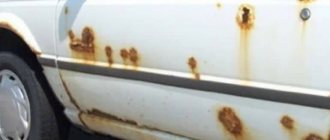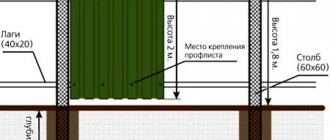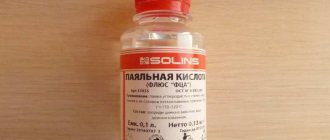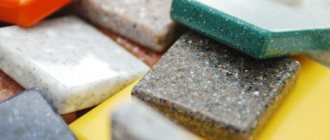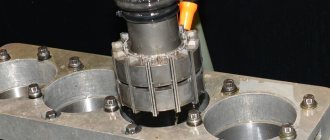The car is rusty - does it happen? “Well, certainly not mine!” – you shake your head. - “Only old rattlesnake rusts!” Sure?!
Alas, this is not true. Any car is subject to corrosion: both the ancient “monsters” of the domestic automobile industry and the very “young” modern foreign cars.
What to do if you unexpectedly find an area of oxidation on the body? First of all, don’t panic - everything can be fixed, and it’s likely that you’ll get by with “little blood” and solve the problem yourself. How to treat rust on a car, how to stop the corrosion process and which product to choose to remove rust from a car – we’ll look at this in this article.
What causes rust?
The classic reason for the appearance of rust is familiar to everyone: chemical reagents, salt solutions and sediments get clogged into chips (available on the body of any car that at least sometimes leaves the garage) and, under the influence of humidity and temperature changes, begin to corrode the metal. This is how the first “bugs” appear - small pockets of corrosion, noticeable only upon detailed examination. However, if you do not attach importance to them, they can soon grow to incredible sizes. And this is the main strength and danger of corrosion - like a cunning enemy, it acts secretly, absorbing more and more new areas of the body. This is why efficiency is so important in the fight against rust: it is always much easier to solve the problem while it is minor; otherwise, after a couple of months of delay, you risk discovering that the process is so advanced that you won’t be able to manage without professional help (=additional financial costs).
1-preparation
- First, the area of the body where rust has appeared must be thoroughly cleaned of dirt . Therefore, before processing, visit a car wash. If it is not possible to completely wash the body, at least rinse and dry the area being treated.
- It is advisable to tape off areas of the body around the work area . Use masking tape to outline the boundaries of your work. To cover the rest of the body, it is better to use a special film for painting the body, and cover the joints with adhesive tape. This will prevent the paint from getting onto other surfaces.
- Choose a suitable day. To ensure that all layers dry properly, it is best to start processing the car on a warm, windless day .
- Decide on a location. You cannot paint a car in an unventilated enclosed area - you may get poisoned. It is better to carry out work outdoors .
- Get equipped. Before carrying out work, put on rubber gloves, goggles, and a mask . If possible, use a respirator. When you start processing, dust from rust, primer, paint will rise into the air - protect your lungs and eyes.
Helpful information:
- Protecting your car from rust: DIY anti-corrosion treatment
- How to remove scratches on a car body with your own hands?
- Do-it-yourself car body polishing
- Protecting your car from salt in winter: we give the reagents a tough fight!
- Arches under the castle: a little about the importance of lockers
- Washing your car in winter: rules of cold cleanliness
You can get professional advice when selecting a product by calling 8 800 555-43-85 (calls within Russia are free).
2-stripping
- It is easier and more convenient to clean the surface using a polishing machine . It will quickly remove rust and is also easy to operate.
- If it is impossible to get the machine, and the damaged area is small, you can use abrasive coarse-grained paper or just sandpaper.
- You need to start processing with a coarser grit (80) and finish with a fine abrasive (150).
- The task of this stage is to remove the layer of paint and primer, reaching the metal of the body, and remove most of the rust. And also - to make the transition from undamaged paintwork to the damaged area smooth.
Process Features
The disadvantages of using wheels include the high consumption of abrasive tools and the need for skill in such work.
Sandblasting and waterjet cleaning are indispensable when working in hard-to-reach places that cannot be reached with a brush or wheel. The technology allows you to get rid of not only rust, but also carbon deposits, scale, and old paint.
The sandblasting process involves exposing metal to sand jets supplied under pressure. The installation includes a compressor, a container with sand and a gun for supplying abrasive.
When waterjetting or hydrosandblasting, a mixture of abrasive material and water is supplied. Delivery occurs at high, low or ultra-high pressure levels. Low intensity saves material, but after the surface dries, signs of secondary corrosion appear.
High supply pressure almost completely removes all deposits. In some areas, traces of black oxides and durable coating sometimes appear. Ultra-high abrasive supply pressure allows you to obtain an absolutely clean surface.
Both methods are only applicable in production environments.
3-processing
- After stripping down to metal, the damaged area must be treated with a special agent - a corrosion converter . It will remove small particles of rust, dust and primer and stop the process of metal destruction.
- Rust converters are available in different forms - liquids, aerosols, gels. The operating principle is the same: phosphoric acid in the product interacts with the oxidized surface and creates an airtight film. Thus, the chemical reaction of metal oxidation (rust) stops.
- The product must be applied strictly according to the instructions. Be sure to protect your skin from contact with the drug.
Causes and places of rust on a car body
Rust is the oxidation of metal that occurs under the influence of air, water and static electricity. Therefore, the main reason for its occurrence is damage to the paintwork of the car body. Microcracks and physical damage allow air and moisture to reach the iron. The speed of the destructive impact will depend on the degree of protection of the body itself and the aggressiveness of the environment. This is especially true in winter, when many chemicals appear on our roads.
The above factors directly affect the shape, color and depth of corrosion. People call them differently: “saffron milk caps,” “bugs,” or simply “rusty spots,” but their essence is the same (only the degree of neglect varies). A single spot of rust is easier to deal with than many small red spots. The latter usually indicates poor quality metal or unsuccessful body repairs. The total processing area will be larger. Moreover, these points often spread in depth rather than in breadth. Blistering of the paint also signals the need to remove corrosion that has begun to develop under the paintwork.
The most common places for bugs and rust spots (photo)
Thresholds Arches Wings at the arches Trunk
Rust progresses well in places where there is increased exposure to foreign objects: sand, dirt, stones. The hood suffers from small stones from the tires of other cars, the wheel arches from their own “emissions” (by the way, wide non-standard tires or rims contribute to greater damage). The thresholds of the car are also one of the first to rot due to the close proximity to the “aggressive environment”, plus unsuccessful exits from curbs aggravate the situation.
Mechanical method
The mechanical method of anti-corrosion cleaning using hand tools or special equipment is considered effective and reliable. Wire brushes, grinding and grinding wheels, a hydro-sandblasting device, and a sandblasting installation are used.
Structure of a sandblasting machine
Minor areas of damage are cleaned with wire brushes before painting. The brushes are also suitable for pre-cleaning thick layers of rust and weld seams.
The work is accompanied by the formation of a large amount of dust, which is a significant drawback.
The use of grinding and cleaning wheels gives the best result in terms of the quality of the cleaned surface. Wheels are effective when processing small and medium-sized areas.
An abrasive tool for removing traces of corrosion and cleaning the surface for painting from traces of paint is selected subject to several conditions:
- the hardness of the material being processed should be significantly lower than the hardness of the wheel;
- medium grain size is suitable;
- The diameter of the circle is selected in accordance with the processing area.
Thermal method
Cleaning metal from signs of corrosion is often done thermally. An oxy-acetylene torch is used for heating. The entire rusty surface is treated with a burner. After completing the procedure, old paint, rust and mill scale burn out and are easily removed.
In order to prevent the re-formation of rust, it is recommended to treat metal products with anti-corrosion compounds.
4-preparation for painting
- After the rust converter has completely dried, the surface of the metal and paint around it should be gently sanded with fine (120) grit sandpaper.
- Then comes the surface priming stage . Before applying the primer, you need to degrease the surface with solvent or WD-40. The primer is applied according to the instructions, usually 3 layers are enough. You should wait a few minutes between each application.
- Paint is applied only after the primer has completely dried. Usually you have to wait 10-12 hours.
5-painting
- Buy a can of paint that is as close as possible to the color of your car.
- For the best match, find information about the paint shade that was used on your car model's factory paint and select paint from a catalog.
- Before painting, treat the primed surface with fine abrasive (400) sandpaper soaked in water. This will create a flat, smooth surface. Then wash the primer with soapy water and dry.
- Apply the paste in a thin layer, in several approaches .
- Typically the paint takes 24-36 hours to dry.
Available means
Each method is specific in its own way. Currently, there is a huge selection of manufactured chemical compounds. You can deal with rust using improvised means that can be found in any home.
Fish oil and baking soda
Fish oil helps to remove corrosion on metal. It should be applied to the problem area and left for several hours. This product helps quickly remove corrosion and creates a thin film on the metal, which will subsequently protect it from the reappearance of rust.
The next remedy is to use baking soda. It must be added to the water in such an amount that the consistency resembles a hair mask. Then the resulting mixture is applied to problem areas and left for 30 minutes. After this, the surface is rubbed with a metal scraper, and if the rust cannot be removed, then this procedure is repeated.
Potatoes and vinegar
When iron is slightly damaged by corrosion, potatoes are used, which helps quickly remove rust. To do this, raw potatoes are cut in half, the fresh cut is sprinkled with rock salt or smeared with laundry soap, after which the rusty area is thoroughly rubbed.
To clean a metal object, mix equal parts acetic acid and lemon juice and apply it to the rust. This product perfectly removes corrosion on metal and red stains on clothes. The exposure time for metal is several hours, and for fabric – about 20 minutes. After this time, the rusty stain on the fabric is wiped with a brush, and on the metal - with steel wool. After removing the rust, the item must be washed.
Citric and oxalic acid
A strong solution of citric acid helps to clean metal from corrosion; for this, take 3 sachets of the product per 1 liter of water.
The resulting liquid must be brought to a boil and the gas must be turned off. Damaged items (bolts, nuts, pliers, screwdrivers, keys, etc.) are placed in the hot solution. The water will immediately begin to bubble. The products must be soaked for at least 8 hours. Softened rust is removed with a sponge or brush. The procedure involving the use of oxalic acid should be carried out in a well-ventilated area
When doing this, you must be especially careful: wear rubber gloves, a gown and safety glasses. If acid gets into your eyes or skin it will cause severe burns.
To prepare a solution to remove corrosion, you need to add 4 tablespoons of acid to a glass of warm water. Before soaking, the metal object is washed with dishwashing detergent and dried. The product should remain in this solution for about 30 minutes. After this, use an old toothbrush to remove rust from the item.
Lime and salt
Acid and salt have a detrimental effect on rust. The citrus must be cut in half and squeezed as much juice as possible onto the rusty areas. Wet areas should be sprinkled with salt on top.
The lime peel should not be thrown away because it will be used as a “sponge” when cleaning off softened rust. After 2 hours, you can try to remove oxidation from the metal. If it does not respond well, then you should wait some more time. Lime can be replaced with lemon, but it will not be as effective.
Thus, to remove rust from metal objects at home, you can use various methods. Any product intended for these purposes is very toxic to both humans and metal
You need to take precautions to avoid accidentally hurting yourself.
